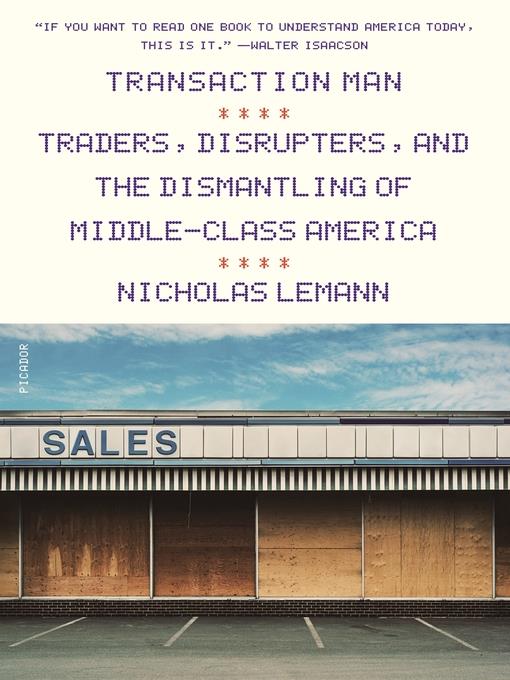
Transaction Man
The Rise of the Deal and the Decline of the American Dream
کتاب های مرتبط
- اطلاعات
- نقد و بررسی
- دیدگاه کاربران
نقد و بررسی

April 1, 2019
To explain our wrenching inequality, New Yorker staffer Lemann starts with Adolf Berle, FDR's chief economic theorist, who envisioned a society dominated by large corporations; moves to Harvard Business School's Michael Jensen insisting in the 1970s that it's all about maximizing shareholder value; to LinkedIn cofounder Reid Hoffman dreaming that "networks" can repair our social fabric.
Copyright 2019 Library Journal, LLC Used with permission.

July 15, 2019
A fresh account of the magnitude of inequality in America and how it came to be. New Yorker staff writer Lemann (Emeritus, Dean/Columbia Journalism School; Redemption: The Last Battle of the Civil War, 2006, etc.) turns to complex theory to explain why income inequality has deepened in conjunction with the fracturing of social bonds between and among the ultrawealthy, middle-class residents, and those struggling with poverty. The author posits that three phases, dating back about 100 years, explain much of the upheaval: the era of powerful institutions, including government, political parties, massive corporations, massive labor unions, and affinity groups based on ethnicity; the era of transactions that often bypassed those institutions, mostly through Silicon Valley and Wall Street; and now, the era of internet-enabled entities such as Google, Apple, and Facebook. Lemann chooses one individual to explicate each phase: New Deal economist Adolf Berle as "Institution Man," Harvard Business School professor Michael Jensen as "Transaction Man," and LinkedIn co-creator Reid Hoffman as "Network Man." Though the author's high-level theorizing is confusing at times, he wisely offers general readers a solid foundation by discussing the impact of each era on citizens in specific neighborhoods, especially a neighborhood on the South Side of Chicago called Chicago Lawn. In that setting, he provides sharp portraits of a white male automobile dealer, an African American woman who migrated from the Deep South to fend off virulent racism in the neighborhood, and other residents struggling to make sense of the increasing economic inequality plaguing much of the country. The desires of Berle, Jensen, and Hoffman to create an orderly, prosperous society allowed a small slice of the citizenry to thrive beyond their wildest dreams but left the vast majority to struggle consistently with poverty. Lemann relies on his well-developed skills as a longtime journalist to weave the specific and the abstract into a narrative that is intellectually challenging.
COPYRIGHT(2019) Kirkus Reviews, ALL RIGHTS RESERVED.

Starred review from July 29, 2019
New Yorker staff writer Lemann (The Promised Land) describes the evolution of American corporate culture in this excellent and unusually framed economic history. Lemann describes how the American worker once dedicated his or her life to a single company, receiving generous benefits, career-long job security, and a pension, whereas the transaction man labors at the mercy of corporate shareholders who may sell, break up, or merge a company to maximize share price. Lemann attributes this change to the work of economists Milton Friedman, who believed the sole function of corporations was to maximize profits for shareholders, and Michael Jensen, who justified rapacious junk bond trading, hostile takeovers, and debt-leveraged buyouts. Lemann also depicts this transformation of the American economy at the micro level through its effect on one neighborhood, Chicago Lawn, which saw the disastrous dissolution of its auto dealerships after General Motors’ bankruptcy. He thoughtfully links income inequality to the transactional theories of the corporation and looks ahead to a possible future model for “pluralism,” wherein political and economic power is diffuse and distributed, rather than held in “institutions, transactions, or networks.” This concise and cogent history of the theories that have transformed the American economy makes a potentially dry subject fascinating.

























دیدگاه کاربران